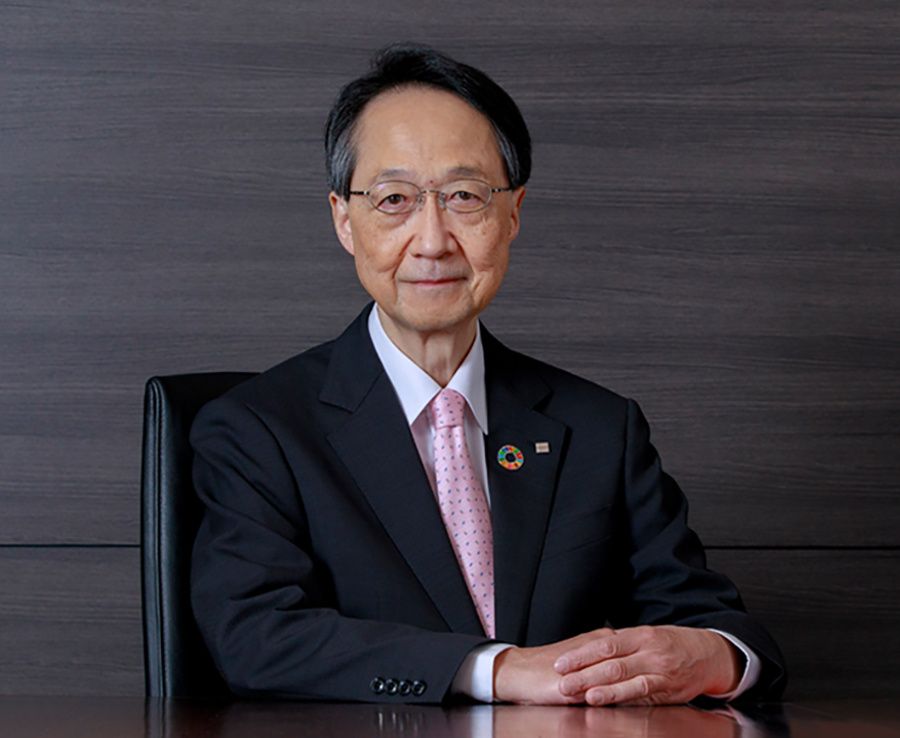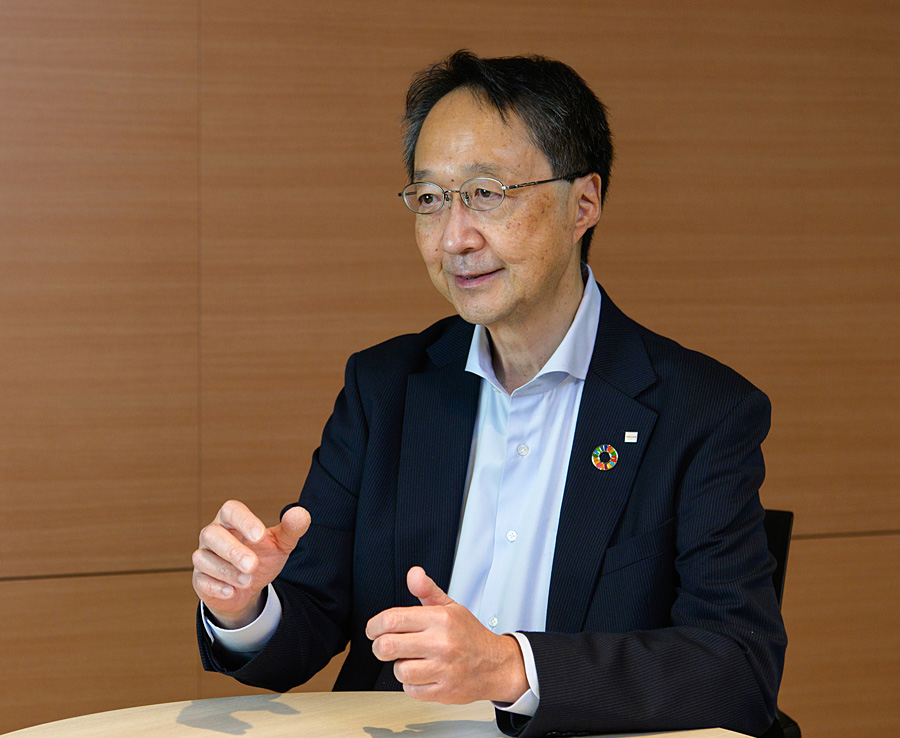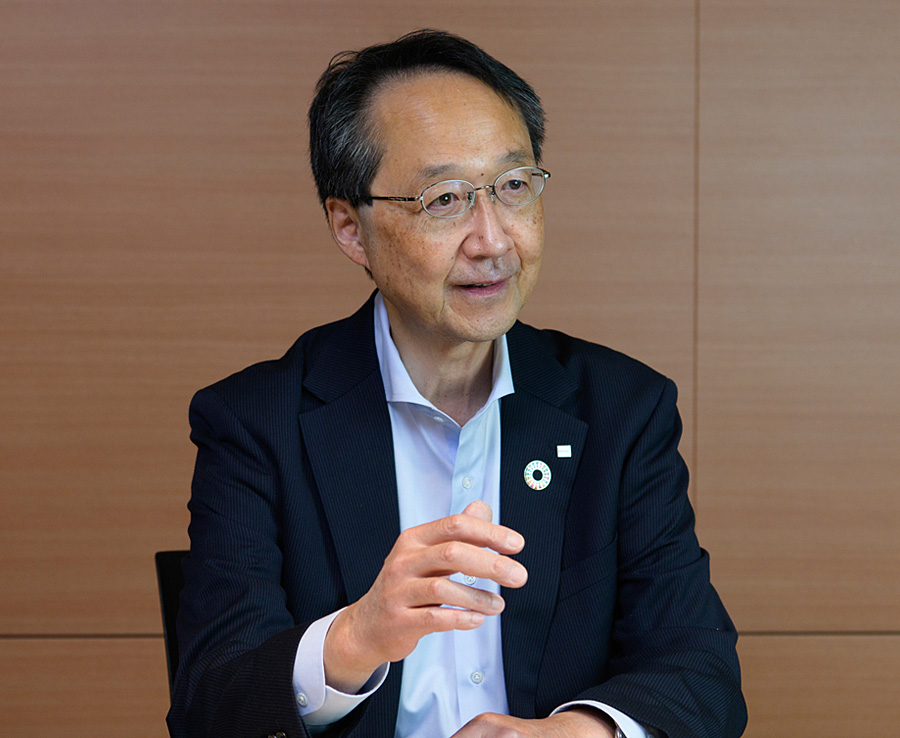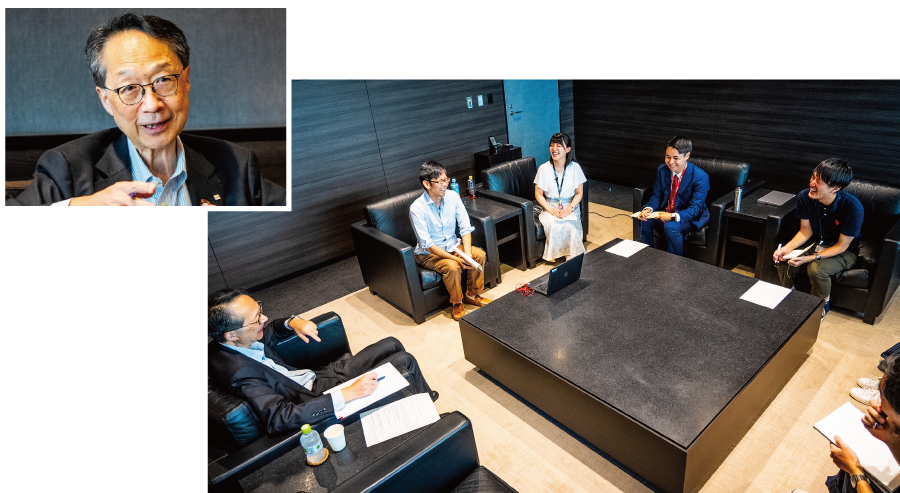- Home
- About Ricoh
- Integrated Report
- To Our Stakeholders
To Our Stakeholders

Transforming into a digital services company that empowers workers’ creativity by remaining close to customers
Akira Oyama
President and CEO
Engaged in sales for original equipment manufacturer products for overseas market and domestic sales subsidiary in Tokyo
Later posted to units in Europe and the Americas, taking part in post-merger integration processes for affiliates purchased there
April 2011
August 2012
CEO of Ricoh Europe PLC
April 2014
General Manager of Corporate Division of Ricoh Company, Ltd.
June 2015
June 2016
April 2017
April 2021
President of RICOH Digital Services Business Unit
June 2021
April 2023
September 6, 2023
Championing diversity and self-motivation to build trust
I am honored to have taken the helm at Ricoh in April 2023. At the same time, the increased responsibilities that I have undertaken are humbling.
That month, we revised the Ricoh Way, our corporate philosophy, positioning Fulfillment through Work as our Mission and Vision. We will materialize our objectives by accelerating our transformation into a digital services company that remains close to customers and empowers workers’ creativity.
My mission as CEO is to enhance Ricoh’s corporate value and lead the company toward a brighter future. I will do my utmost to help Ricoh earn the trust of all stakeholders, including shareholders, employees and their families, customers, business partners, and society.
I spent much of my career overseas, particularly in Europe and the United States. This experience underlined the importance of diversity in organizational management. I have valued communicating well with people because languages and cultures vary dramatically across countries and regions. When in Europe, I fostered a culture that embraced the diversity of our people. We took their personalities and opinions into account. We respected wide-ranging ideas to generate new synergies. A homogenized organization never evolves. Achieving our transformation into a digital services company, we will champion employee diversity and encourage our people to pursue new challenges by supporting their growth, thereby driving our business growth.
Anticipating changes in work environments to capitalize on business opportunities
The world has experienced rapid changes since the COVID-19 pandemic. As social conditions change, work environments and the circumstances and attitudes of working people are transforming faster and faster. Hybrid work has established itself worldwide. People decreasingly view offices as the sole locations for white-collar work and see them increasingly as spaces to inspire creativity.
In addition, the evolution of AI, including the emergence of generative AI, has been remarkable, and the value expected of workers is rapidly changing along with it.
On top of that, worker attitudes have changed. The psychological aspects of work have become more important in recent times. While needing to earn a living, people also seek fulfillment through their jobs. They want to accomplish things. This comes from creating value. So, we believe that enhancing such creativity is becoming increasingly important.
I sense that such changes in our operating climate offer tremendous potential. I am also convinced that Ricoh is heading in the right direction, which is to help people become more creative by leveraging digital technology and contributing to a sustainable economy.
Reviewing our 20th MTP: Implementing decisive reforms and completing the runup to transforming into a digital services company
We devoted considerable energy to our transformation as a digital services company under our 20th MTP. We made acquisitions and other growth investments while internally overhauling our organization, structure, and IT systems to strengthen our management underpinnings. In April 2021, we adopted a business unit structure, transferring authority to those entities so they can respond swiftly to changes in their markets. In managing returns on invested capital and our business portfolios, we accelerated efforts to become more profitable and reform our structure. We also bolstered talent to execute our strategies better. In April 2022, for example, we introduced a Ricoh-style job-based personnel system in Japan. At the same time, we had to tackle business climate changes that had occurred in recent years. Disruptions in the global supply chain led to delays in equipment supplies, particularly of MFPs, detracting from our results.
In fiscal 2022, the final year of the 20th MTP, sales exceeded our initial target, reaching ¥2,134.1 billion. Operating profit was below our initial projection, at ¥78.7 billion. Our return on equity (ROE) was lower than anticipated, at 5.9%. This reflected such factors as delayed print volume recoveries, shortages of hardware components, and surging raw materials prices. On the upside, we progressed steadily with efforts to resolve social issues, earning high regard worldwide for these endeavors. We position ESG targets as future financial targets because ESG initiatives enable us to avoid risks and ultimately capitalize on emerging business opportunities. We will keep pushing forward with ESG and implement our management stance of aligning efforts to create a sustainable economy and drive business growth.
21st MTS: Deploying three basic policies to generate groupwide synergies

We initiated the 21st MTS in April 2023. Under that three-year initiative, we seek to deliver steady progress as a digital services company. For fiscal 2025, the final year of that plan, we target an operating profit of ¥130 billion and a return on equity of more than 9%. We will reach those goals by progressing with three basic policies. These are to reinforce regional strategies and evolve Group management, build revenue sources in frontlines and social domains, and leverage global talent.
The first key point in reinforcing regional strategies and evolving Group management will be to amass recurring revenues from digital services and enhance profitability. We will transform our earnings structure by lifting digital revenues from 44% of sales to more than 60%. It will accordingly be important to improve our ability to create value through customer touchpoints, leverage synergies within the Ricoh Group, and tackle business climate changes. These efforts will enable us to become more profitable and ultimately enhance corporate value.
Under the second basic policy, which is to build revenue in frontlines and social domains, we will broaden digital services and progressively expand our frontline businesses to provide value to a wider range of customers, thus helping to resolve social issues. We will determine priority business areas to build this revenue.
For the third basic policy of leveraging global talent, we will shift people to growth areas and maximize the value our people produce globally. We will simultaneously achieve employee and business growth and enhance our profitability.
Steadily undertaking these measures will make us more profitable and enhance corporate growth.
Establishing recurring revenue business with our unique digital services

Our basic policy of reinforcing regional strategies and evolving Group management is central to building recurring revenues from digital services.
Our printing business has generated stable earnings through high-margin recurring revenue businesses. These include selling consumables for printing and maintenance services at customer sites, starting from flows in selling MFPs. We will ensure growth as a digital services company by accelerating efforts to create new recurring revenues that augment our printing business. We will offer a range of digital services that address specific customer issues. We will thereby expand our recurring revenue businesses, including device and IT environment support services and Software as a Service application services, to build and grow a revenue stratum.
The digital services market offers excellent growth potential. Our global customer network through such hardware as MFPs is one key strength. Our many unique and outstanding edge devices serve as gateways between analog information, such as text, photos, audio, and videos, and the digital information that machines and software process. We integrate these edge devices with a range of applications and services that we and our partners provide through the RICOH Smart Integration platform to help digitalize work processes for customers. Service and support through a specialized structure are essential for small and mid-sized corporate clients because such entities typically lack in-house IT expertise. So, we are convinced that we can leverage the strengths of an industry-leading sales and support structure that is close to customers to become a market leader.
We are steadily pursuing acquisitions and business alliances globally to strengthen our ability to deliver digital services. It was in keeping with that approach that in fiscal 2022 we acquired PFU Limited, the world’s top provider of business scanners. In May 2023, we announced that we would form a joint venture company by the first half of fiscal 2024 that gives us a technological edge by integrating the MFP and other device manufacturing and development of Ricoh and Toshiba Tec Corporation. Competitive edge devices are vital to delivering digital services. We will become even more competitive and robust in manufacturing by bringing together the technologies and expertise of our Group and our partners to generate synergies. Also, we are broadening the scope of workflow digitalization by expanding our application lineup, including through a business partnership that we formed in fiscal 2022 with Cybozu, Inc., to deploy the RICOH kintone plus solution in Japan and North America. We are focusing on enhancing the digital services consultation skills of our digital professionals.
Simultaneously contributing to both employee and business growth through our Fulfillment through Work ethos

Holding a roundtable meeting
with third-year employees
I believe that employee growth drives corporate growth. Under the 20th MTP, we deployed a range of personnel initiatives, including developing digital professionals. We base that approach on the concept of human capital. We view personal abilities and skills as capital and appropriately invest in them. We are empowering our people to tackle new challenges, such as by expanding digital training programs and harnessing people globally. We will foster a corporate culture that provides Fulfillment through Work by encouraging self-motivation and personal growth. We believe that Fulfillment through Work represents a vital virtuous cycle. It serves as a new engine of employee growth that fuels sustainable corporate expansion. We have conducted global employee engagement surveys asking respondents to explain the contributions they make to Ricoh becoming a digital services company. These polls have revealed steadily rising numbers of employees able to detail their own contributions to that effort and to society in the process. Personal and business growth will simultaneously flourish by optimizing the performances of individual employees.
I realize we need to more clearly articulate our journey as a digital services company to the capital markets while delivering firm figures from our efforts. We will build a solid track record in digital services so we can confidently increase cash flow in the coming years. Companies should target a price-to-book value ratio that is greater than 1. Right after taking the helm, I immediately embarked on a project to reach or exceed that level. Our first priority is to steadily enhance our ROE and earnings per share, as we can control these metrics. Our capital strategy emphasizes profit growth and manages capital costs by employing a Ricoh-style return on invested capital tree while prioritizing shareholder returns. At the same time, we will be a global top runner in ESG initiatives, which we have positioned as future finance endeavors.
Ricoh seeks to keep supporting customer creativity by delivering Fulfillment through Work well into the future. We will continue to grow, staying close to customers and remaining a respected and trusted corporate citizen.